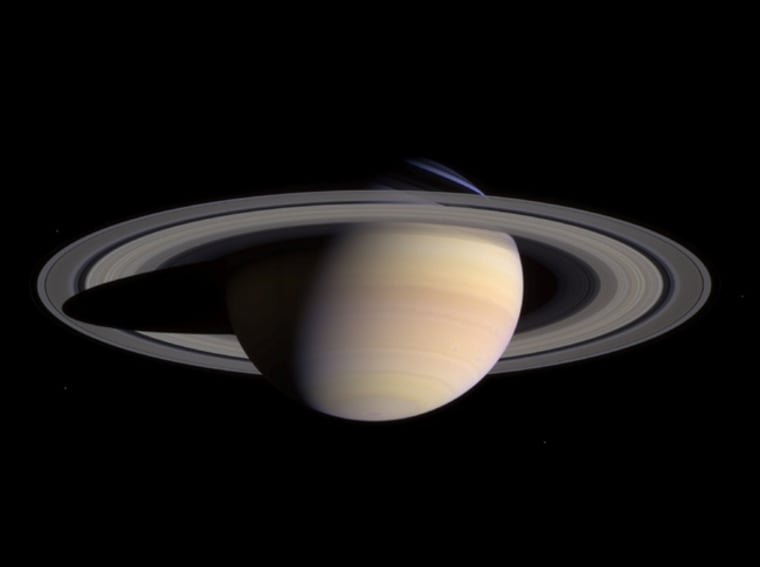Saturn's rings have fascinated scientists ever since Italian astronomer Galileo Galilei first spotted them through one of his telescopes in the 17th century. But just how the icy rings came into being remains a mystery that has only deepened with each new scientific finding.
Astronomers now know that the planet hosts multiple rings that consist of roughly 35 trillion-trillion tons of ice, dust and rock. The Cassini spacecraft and its Voyager predecessors have also spotted changing ring patterns, partially formed ring arcs and even a moon spewing out icy particles to form a new ring. All of this suggests that the rings have constantly evolved over time.
Cassini also imaged a more recent event near the time of recent Saturn equinox, when an object apparently punched through one of the rings and left a scarred wake of debris that again points to a dynamic, ever-changing system of rings.
Yet even today, just how and when each of the rings each formed remains unknown.
Not just bands, but rocks
Scientists have learned much since Dutch mathematician Christiaan Huygens followed up on Galileo's first sighting and figured out what the rings represented in 1655. The rings consist of icy clumps, mud, rock and even moonlets that can cause gravitational mayhem by dipping in and out of rings.
Jupiter, Uranus and Neptune also have fainter sets of rings. But uncertainty still holds sway over how Saturn amassed such a spectacular ring collection, which scientists have organized from the innermost to outermost ring by the following divisions: D, C, B, A, F, G and E.
One theory suggests that the rings resulted from the debris of a shattered moon from around 4 billion years ago, during a period of heavy meteorite bombardment. A large comet or asteroid collision could also explain the swarm of debris.
Another theory proposes that the rings represent primordial throwbacks to an early disk of debris that failed to clump into moons, based on how Saturn's gravitational tidal pull constantly stirs the pot.
Slideshow 12 photos
Month in Space: January 2014
Strange structures and gaps exist within the rings. Voyager first spotted ghostly patterns cutting across the rings like spokes on a wheel, and Cassini also imaged such spokes. No agreement exists on whether the spokes arose from meteoroid impacts on the rings or instability in Saturn's magnetic field. Scientists have even pointed to Saturn storms or perhaps lightning as possible culprits behind the phenomenon.
Other gaps shaped like airplane propellers may have formed in the rings when stadium-sized moonlets plowed through the orbiting ring particles. The presence of thousands of these moonlets could lend weight to the collision theory for Saturn's ring formation.
Time after time
The age of Saturn's rings also remains open. Earlier Earth-based observations leaned toward the ancient rings dating back billions of years, toward the beginning of the solar systems 4.6-billion-year history. By contrast, Voyager's swing-bys suggested a more youthful age of perhaps 200 million years or so, when dinosaurs had begun to walk the Earth.
Cassini's ongoing tour of the planetary system has complicated matters by indicating that each ring may have formed at different times and in different ways. The NASA spacecraft found that icy plumes from the moon Enceladus constantly feed the E ring with new material. Smaller inner moons also orbit within partial and complete rings formed from their own particles, probably due to impacts from micrometeroids blasting the material off their surfaces.
Some rings also apparently renew themselves in a way that could explain the age discrepancy, according to Todd Barber, Cassini's lead propulsion engineer. He discussed current ring theories with Linda Spilker, Cassini's deputy project scientist.
"Apparently, B-ring material may be ancient but prone to bouts of recycling, continually clumping but then breaking up to expose fresh (and young-looking) water ice," Barber said. "Evidently, everything old is new again, but perhaps old again."
Of occultation and equinox
Scientists have gotten several breaks over the past years in better understanding Saturn's rings. Cassini managed to image all of Saturn's rings at once in 2006, when the sun passed directly behind Saturn and remained blocked by the planet for 12 hours.
Another rare event this August allowed Cassini to examine the vertical depth of the rings during the Saturn Equinox, an event that only takes place every 15 years. That's when the rings turn edge-on toward the sun and reflect practically no sunlight.
"Whenever equinox occurs on Saturn, sunlight will hit Saturn's thin rings, the ring plane, edge-on," Spilker noted.
So far, however, even the power of Cassini – named for Giovanni Domenico Cassini, who discovered moons of Saturn and was the first to spot a huge division in the rings that now bears his name — has not revealed all of Saturn's secrets.
Cassini's extended tour through 2017 may allow the spacecraft to keep pursuing the many mysteries embedded within the rings. Scientific goals include narrowing the age of the rings by examining the rate of meteoroid infall contamination, gauging ring mass, seeing how propeller features form, and figuring out how narrow ring gaps end up relatively cleared of debris.
"Like any great magician, Saturn never fails to impress," Spilker said. A bit of occultation and equinox doesn't hurt, either.
More on: Saturn

